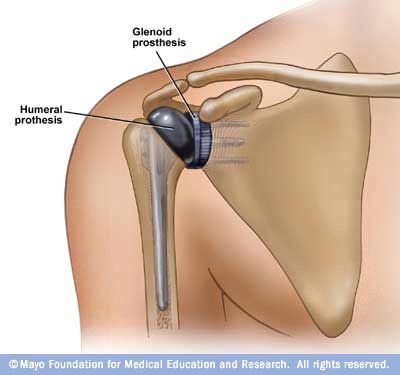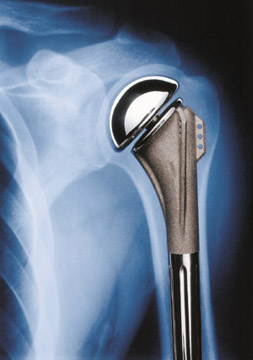Bone ingrowth into a shoulder prosthesis
Elise van Aken
Site of the project:
Hospital
start of the project:
October 2006
In February 2007 the
Interim
Thesis has been appeared
and a
presentation has been given.
The Master project has been finished in September 2007
by the completion of the
Masters Thesis
and a final presentation
has been given.
For working address etc. we refer to our
alumnipage.
Summary of the master project:
After a long period of functioning a joint (such as a shoulder, hip or
knee) may fail
due to mechanical wear and tear, osteoporosis (decrease of the
bone-density),
osteoarthritis or rheumea (decay of cartilage). As a consequence, the
patient is faced with
a lot of pain and mobility limitations. In some cases this problem can
be solved by the
replacement of the glenoid (which is the cavity of the
shoulderblade in which the
upper arm fits) of the shoulder joint with a prosthesis. The
prosthesis
consists of porous material on the bone-side. After positioning of
this prothesis, by
replacement of the cavity of the shoulder joint, bone is supposed to
grow into the
prosthesis such that the prosthesis becomes integrated with the
shoulderblade. This
enhances a stable position of the cavity of the shoulder prosthesis in
the shoulderblade.
A crucial aspect is the stress distribution in the shoulderblade,
since the human body
has been constructed such that growth of bone takes place if a
threshold mechanical
stress has been exceeded. If the stress is lower than this threshold,
then, no
bone ingrowth will occur and even the present bone will decay ( bone
resorption).
Of course, the latter case is undesirable. The mechanism is logically
sound: At those
positions without mechanical loading, no bone is needed and hence the
present
bone will disappear. If the body is loaded, then, bone has to be
reinforced. A crucial
question is here: Does the mechanical loading / stress exceed the
threshold necessary for
bone ingrowth into the prosthesis and will the bone of the
shoulderblade remain intact?


To answer these questions, the stress distribution over the
shoulderblade and prosthesis
is computed. The contact between the prosthesis and the
shoulderblade and the difference in material properties are dealt with
in the simulation.
A further assumption in the simulation is that the arm of the patient
moves up and down.
This gives a boundary condition for the computation of the stress of
the prosthesis
and shoulderblade. For the relation between the stresses and strains,
Hooke's Law is
used. The set of governing partial differential equations is solved
using a finite
element procedure.
In the present three-dimensional simulations a coupling between the
solution of the
mechanical equations for the stress and the equations for bone
ingrowth is currently
lacking. The ingrowth of bone provides a change of the bone density.
This change
influences the solution of the mechanical equations. Besides the
medical / mechanical
interest of this project, the largest mathematical challenges are
provided by the
solving the three-dimensional problem and the nonlinear coupling
between the
mechanical equations and the models for bone ingrowth.

Contact information:
Kees
Vuik

Back to the
home page
or the
Master students page of Kees Vuik


![]()
![]()